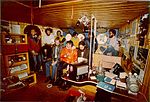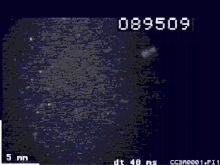This article has multiple issues. Please help improve it or discuss these issues on the talk page. (Learn how and when to remove these messages)
|

The Antarctic Technology Offshore Lagoon Laboratory (ATOLL) was a floating oceanographic laboratory for in situ observation experiments. This facility also tested instruments and equipment for polar expeditions. The ATOLL hull was the largest fiberglass structure ever built at that time. It was in operation from 1982 to 1995.
Structure and infrastructure

The ATOLL was composed of three curved fiberglass elements, each 25 m (82 ft) long and having a draught of only 38 cm (15 in). For towing, the elements could be assembled in a long S-shape; in operation, the elements would form a horseshoe shape surrounding 150 m (1,615 sq ft) water surface. The lab provided ample space for twelve researchers. The laboratory contained a lab, storage and supply facilities, a dormitory, computer room, and a fireplace.
The laboratory was installed and operated in the Baltic Sea (and the Bay of Kiel in particular) at the initiative and under the direction of Uwe Kils, at the Institute of Oceanography (Institut für Meereskunde) of the University of Kiel. The fiberglass hulls themselves were bought from Waki Zöllner's "Atoll" company.
The onboard computer was a NeXT and the first versions of a virtual microscope of Antarctic krill for interactive dives into their morphology and behavior were developed here, finding later mention in Science magazine. The lab was connected to the Internet via a radio link, and the first images of ocean critters on the internet came from this NeXT. The first ever in situ videos of Atlantic herring feeding on copepods were recorded from this lab.

An underwater observation and experimentation room allowed direct observation and manipulation through large portholes.
The technical equipment included an ultra-high-resolution scanning sonar that was used for locating schools of juvenile herring, for guiding a ROV, which was controlled via a cyberhelmet and glove, and for determining positions, distances, and speeds. Probes measured the water salinity, temperature, and oxygen levels. Special instruments could measure plankton-, particle-, and bubble-concentrations and their size distributions. Imaging equipment included low-light still and high speed video cameras using shuttered Laser-sheet or infrared LED illumination. An endoscope-system for non-invasive optical measurements called ecoSCOPE, which could also be mounted on an ROV, was developed and used to record the microscale dynamics and behavior of the highly evasive herring.
Research

Scientific investigations aboard the ATOLL concentrated on one of the most important food chain transitions: the linkages between the early life stages of herring (Clupea harengus) and their principal prey, the copepods. A major hypotheses of fisheries ecologists is that the microdistribution of prey, the microturbulence of the ocean, or the retention conditions are normally not suited to allow strong year classes of fish to develop. In most years more than 99% of herring larvae do not survive. Occasionally however, physical and biotic conditions are favorable, larval survival is high, and large year-classes result. Research work at the ATOLL investigated the effects of small-scale dynamics on fish feeding and predator avoidance and their correlation to year-class strength.

Research questions investigated by students during courses and their thesis work at the Laboratory included: What are the effects of the natural light gradient on predator-prey interactions? How can the predator best see the prey without being seen? How does the focussing of small waves oscillating light regime influence camouflage and attack strategy? What are the influences of the different frequencies of microturbulences? How do such effects change at the moment when herring larvae join into schools? What role does the phenomenon of aggregation play? Do ocean physics create or alter organism-aggregations? Can the dynamics of aggregations effect ocean physics at the microscales? Are there effects of the surface waves? What are the distribution and dynamics of microbubbles caused by turbulences and gas-oversaturations? How can the organisms orient in respect to micro-gradients of the ocean physics? How do they survive in the direct vicinity of undulating anoxia and hypoxia? Why are eelpouts, sticklebacks and herrings so extremely successful in the Baltic while cod is not? What are the effects and functions of schooling for feeding and microscale-orientation? What is the behavior of fish in netcages and how much food is lost from the cages. The ATOLL mainly served as a test bed for the development and field testing of equipment such as developing ROVs that were to be used later in Antarctic expeditions, e.g. for in situ imaging of transparent organisms of krill size under the ice.

References
- Waki Zoellner Guinness book of record largest artificial island at that time
- Waki Zöllner's floating artificial islands
- ^ Kils, U., Ruohonen, K., Makinen, T.: Daily feed intake estimates for rainbow trout (Oncorhynchus mykiss Wahlbaum) evaluated with SONAR and X-ray techniques at commercial net cage farms. Coun Meet Int Coun Explor Sea 1991/F3:1–8; 1991
- Kils, U.: "Swimming Behavior, Swimming Performance, and Energy Balance of Antarctic Krill Euphausia superba Archived 16 June 2005 at the Wayback Machine", College Station, Texas; 1 - 122 Archived 13 December 2002 at the Wayback Machine; 1981
- Schulze P., Strickler, R., Bergstroem, B., Berman, M., Donaghay, P., Gallagher, S., Haney, J., Hargraeves, B., Kils, U., Paffenhoefer, G., Richman, S., Vanderploeg, H., Welsch, W., Wethey, D. & Yen, J.: "Video based instruments for in situ studies of zooplankton abundance, distribution and behavior.", Arch. Hydro. Beih. 36: 1–21; 1992
- Thetmeyer, H., Kils, U.: To see and not to be seen: the visibility of predator and prey with respect to feeding behaviour. Mar Ecol Prog Ser 126: 1–8; 1995
- Kils, U.: Formation of Micropatches by Zooplankton-Driven Microturbulences. Bull Mar Sci 53(1) 160-169; 1993
- Fischer, P., Kils, U.: In situ Investigations on Respiration and Behaviour of Stickleback Gasterosteus aculeatus and the Eelpout Zoaraes viviparus During Low Oxygen Stress ICES C.M.1990/F:23; 1990 International Council for the Exploration of the Sea
- Fischer, P., Rademacher, K., Kils U.: In situ investigations on the respiration and behaviour of the eelpout Zoarces viviparus under short term hypoxia. Mar Ecol Prog Ser 88: 181–184; 1992
- Kils, U., Marschall, P.: Der Krill, wie er schwimmt und frisst - neue Einsichten mit neuen Methoden (The Antarctic krill Euphausia superba - feeding and swimming performances - new insights with new methods) In Hempel, I., Hempel, G., Biologie der Polarmeere - Erlebnisse und Ergebnisse (Biology of the Polar Oceans) Fischer Jena - Stuttgart - New York, 201–207;1995 (and images p 209-210)
External links
- ATOLL laboratory
- Kils, U.: The ATOLL Laboratory and other Instruments Developed at Kiel; U.S. GLOBEC NEWS Technology Forum Number 8: 6–9; 1995. Also available as a PDF file.
- Waki Zoellner Zweites Deutsches Fernsehen, ZDF, 1978, Drehscheibe: Waki Zöllner und sein Atoll vor Travemünde. Norddeutsches Fernsehen, NDR, 1978, Atoll vor Travemünde. Bayerisches Fernsehen, BR3, 1980, Samstags-Club: Maria Schell und Waki Zöllner. Zweites Deutsches Fernsehen, ZDF, 1990, Teleillustrierte: Waki Zöllner und sein Floatel
- Newspaper article
- Newspaper article2